|
July 2013

Issue Home >>
|
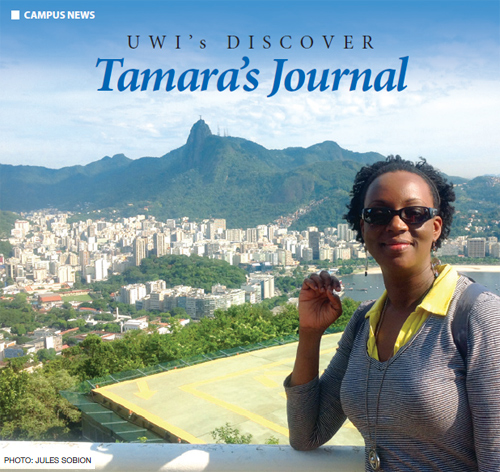 Tamara Brathwaite is a librarian attached to the Institute of International Relations at The UWI, St Augustine Campus. She is also an avid journal writer. Tamara has always wanted to travel under The UWI umbrella and UWI’s Discover provided the opportunity to bring her love for travel and writing together. Travel with her as she discovers that there is more to Brazil and India than what you’d find in the travel books. Tamara Brathwaite is a librarian attached to the Institute of International Relations at The UWI, St Augustine Campus. She is also an avid journal writer. Tamara has always wanted to travel under The UWI umbrella and UWI’s Discover provided the opportunity to bring her love for travel and writing together. Travel with her as she discovers that there is more to Brazil and India than what you’d find in the travel books.
Sao Paolo
May 20, 2013
I admire how when I travel my phone syncs automatically to the new place that I am in, automatically scanning the atmosphere for a signal to which it is compatible so that it can still operate, allowing me to make calls or receive texts. I think international travel is like that. Your inner channel scans the new environment searching for a compatible signal. I may be exaggerating but I think my heartbeat synced with the rhythm of São Paolo at the airport arrival hall, and we have been vibing on the same wavelength ever since!
Our first stop on our four city tour in Brazil brings us to São Paolo. The largest of cities, it is the heart of commerce and demonstrates that Brazil is a country that is more developed than it is developing. Huge traffic jams mean that many of the high rises are equipped with helipads denoting that getting to work by air is an option used by many.
Sao Paolo is a huge metropolis where public art and public displays of affection are commonplace. The city is full of entrepreneurial, artistic, tropically passionate people who freely express their love for one another and for Brazil. They drink tiny cups of black coffee and eat massive servings of sweet desserts ubiquitously consumed by being held in a napkin -- never, never with one’s bare hands!
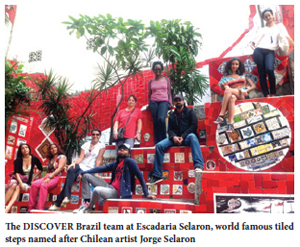 Rio De Janeiro Rio De Janeiro
May 30, 2013
The city of Rio de Janeiro is known as the marvellous city and there is a reason for that. It is nestled between dramatic sheer mountains and the beautiful Atlantic Ocean. The stunning shoreline contrasts with the sharp shale mountains - a perfect spot to locate the former capital of Brasil or Christ the Redeemer, standing watch over his charges. Luckily for us, we stayed at a lovely posada run by a French woman in a quaint mountaintop village called Santa Theresa, with its riotous cobbled stone streets; it provided breathtaking views of the Western side of the capital, and great exercise when we explored its tumultuous alleyways!
Salvador de Bahia
June 2, 2013
As we landed and drove through a bamboo grove that heralded our arrival in the state of Bahia, I felt that there was something hauntingly familiar about the capital city, Salvador de Bahia, the very first capital of Brazil. I experienced an unfamiliar déjà vu, as though some part of my spirit was here before.
What I do know is that of the Brazilian cities that we have visited thus far, Salvador resonated with me. My roommate, Chelsea Marie Mendes, probably got fed up of my whistling David Rudder's “Bahia Girl” every morning but, in the song, I think that there is a line that goes "...you see Trinidad and Brazil has the same vibration" and nothing was ever as true for me as our brief sojourn in Salvador.
Brasilia
June 6, 2013
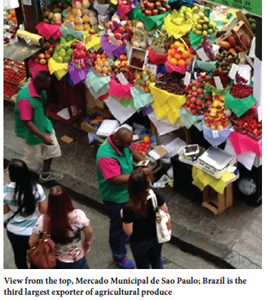 Brasilia. Brasilia. Brasilia. How do I tell you about Brasilia? Inaugurated just about the time that the Caribbean was waking up to the idea of independence in the early 60s, the current capital of Brazil, is a dream come true for a developed nation; it is a modern contemporary planned city straight out of a science fiction novel. In 1000 days, the then government of Brazil fulfilled a constitutional promise to create a new capital in the middle of the country. Brasilia. Brasilia. Brasilia. How do I tell you about Brasilia? Inaugurated just about the time that the Caribbean was waking up to the idea of independence in the early 60s, the current capital of Brazil, is a dream come true for a developed nation; it is a modern contemporary planned city straight out of a science fiction novel. In 1000 days, the then government of Brazil fulfilled a constitutional promise to create a new capital in the middle of the country.
Clearing what was once desert and brush land, to plan and build a city that meets the needs of an exploding population took just four years. Laid out in sectors, the federal district is shaped to resemble a plane, with a central administrative core as the cockpit and supporting sectors as wings. A government sector steers the residential sector, the banking sector, the cultural sector, the diplomatic sector; everything is pretty much sectioned. The area is perfectly symmetrical, so what is on one half precisely mirrors the other.
I guess it goes with the planned city that everything went according to planned and my favourite activity of all in Brazil was meeting and chatting with Ricardo Wahrendorff Caldas, a professor of international relations at the University of Brasilia. I interrogated him about all of the things that I had seen on this trip and he patiently responded. The opportunity to juxtapose these answers later that evening at a dinner hosted by the Ambassador of Trinidad &Tobago to Brazil, Ambassador Hamza Rafeek was stellar! I was able to further satisfy my inquisitiveness about Brazil from a Trini perspective, allowing me to connect all of the dots with regard to Brazil, how it is portrayed, how it is viewed and its place in the world. In the end, it all made sense.
INDIA
The Start – July 21, 2012
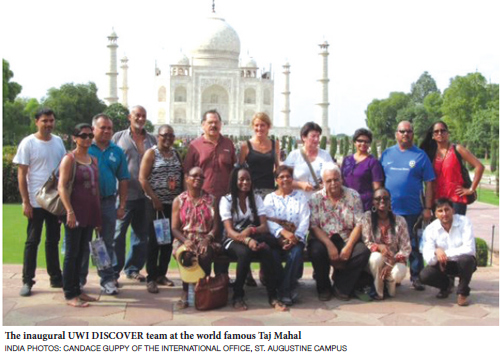 It’s been a week since we've been in India and still the adjectives to describe this experience, escape me. Actually, I don't have an adjective, I have an experience. Night before last, at one of the many welcome receptions, we were given a welcome drink, a fruit punch. It was cool in temperature, brown in colour and ornate with bright green muddled mint leaves, and crunchy bits of local apple floating around in it. It was seasoned, spicy and sweet. To the taste it was sweet yet tart, spicy yet refreshing, strange yet familiar - I could not identify the elements of the drink. Today I asked one of our companions, and it was revealed that it is a drink made from green mangoes. Only then could my tongue recollect the elements of a mango chow in the drink. ambi ka panna it is called. It’s been a week since we've been in India and still the adjectives to describe this experience, escape me. Actually, I don't have an adjective, I have an experience. Night before last, at one of the many welcome receptions, we were given a welcome drink, a fruit punch. It was cool in temperature, brown in colour and ornate with bright green muddled mint leaves, and crunchy bits of local apple floating around in it. It was seasoned, spicy and sweet. To the taste it was sweet yet tart, spicy yet refreshing, strange yet familiar - I could not identify the elements of the drink. Today I asked one of our companions, and it was revealed that it is a drink made from green mangoes. Only then could my tongue recollect the elements of a mango chow in the drink. ambi ka panna it is called.
Ambi ka panna is India, the elements are familiar but the combination of ingredients is unusual to the senses.
The End –August 5, 2012
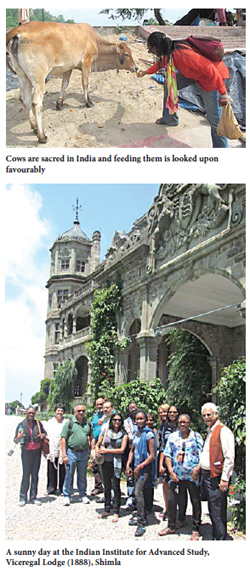 There is no doubt that we have journeyed through India. Six flights, eight hotels, 15 travelling companions... we have been taken from the sweltering capital of New Delhi to the base of the Himalayan Mountains in the North, to the reverent shores of the Ganges River, to the teeming coast of Cochi in the South. We've visited academic institutions, cultural industries and monuments of inspiration; had new experiences of aggressive haggling for bargains, using omnipresent squat toilets and collapsing tiredly at 5 star hotels at varying hours of early or late night. I've tasted new things, seen new sights and heard new sounds and I've come up initially with two truths. There is no doubt that we have journeyed through India. Six flights, eight hotels, 15 travelling companions... we have been taken from the sweltering capital of New Delhi to the base of the Himalayan Mountains in the North, to the reverent shores of the Ganges River, to the teeming coast of Cochi in the South. We've visited academic institutions, cultural industries and monuments of inspiration; had new experiences of aggressive haggling for bargains, using omnipresent squat toilets and collapsing tiredly at 5 star hotels at varying hours of early or late night. I've tasted new things, seen new sights and heard new sounds and I've come up initially with two truths.
I am Indian...West Indian. When probed about where I am from while in India my response as West Indies is greeted by huge smiles and the names of cricketers’ roll off of the tongues of merchants... Gary Sobers, Clive Lloyd, Brian Lara, Chris Gayle! All Indians are keen to engage in discussions on the politics of cricket. It is actually quite refreshing, to be recognised by our sporting ambassadors of a past time. But, prior to the question, I would not have identified myself as West Indian, or even Indian... Though an accident of Columbus is my inherited fate, I don't feel uncomfortable being cast in an Indian light, in that, I can identify with the culture and the practice and the nuances that may not overtly belong to me but is as much a part of my reality as is any West Indian living in Trinidad & Tobago and it is in that regard that I am an Indian that hails from the west, I am a West Indian.
Secondly, as open minded as I know that I am, and I know that I am! My world is small, my ability is challenged by my inability to see as far back as possible and as far forward as infinity. My view is severely limited by my island boundaries and my lack of historical reference. I have travelled to a continent that defies carbon dating, that has monuments older than discovery and prides generations of families dating Before Christ was B.C. The ghosts in India are well preserved. I have travelled to a limitless continent, which has so much to give to the world. There is a forever in India, a forever that will never leave me, since I have been to a place that does not end, that is historically rich, geographically wide and culturally deep. I have the niggling suspicion that though our journey to India has ended; our discovery of India had just begun.
Hardly a nutshell, but these excerpts are some of my thoughts while we travelled under The UWI’s Discover… umbrella. The truth of the matter is that though the journey has ended, the discovery has only just begun.
Obrigada and Namaste, Tamara
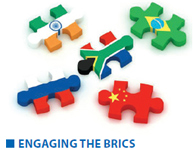 In 2001 Jim O’Neil of Goldman Sachs coined the word ‘BRIC’ in reference to a group of emerging markets that at the time represented “only 15% of the gross national product of the six major advanced industrial economies,” but which economists predicted would catch up to these six in under 40 years. These emerging markets are Brazil, Russia, India, China and now South Africa. In 2001 Jim O’Neil of Goldman Sachs coined the word ‘BRIC’ in reference to a group of emerging markets that at the time represented “only 15% of the gross national product of the six major advanced industrial economies,” but which economists predicted would catch up to these six in under 40 years. These emerging markets are Brazil, Russia, India, China and now South Africa.
The BRIC countries have since gone on to meet and seek out opportunities for cooperation in trade, investment, infrastructure development and other arenas.
In UWI’s Discover, participants are taken on an exploration of these emerging markets. It is a study tour that provides an immersion in the culture, history, politics, architecture and people of these promising economies –led by expert academic tour guides.
In 2012 the series started with a visit to India and continued in 2013 with a visit to Brazil. This August UWI’s Discover will again visit India.
|





